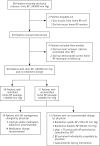Home Blood Pressure Monitoring in Cases of Clinical Uncertainty to Differentiate Appropriate Inaction From Therapeutic Inertia
- PMID: 31937533
- PMCID: PMC7227476
- DOI: 10.1370/afm.2491
Home Blood Pressure Monitoring in Cases of Clinical Uncertainty to Differentiate Appropriate Inaction From Therapeutic Inertia
Abstract
Purpose: Conventional clinic blood pressure (BP) measurements are routinely used for hypertension management and physician performance measures. We aimed to check home BP measurements after elevated conventional clinic BP measurements for which physicians did not intensify treatment, to differentiate therapeutic inertia from appropriate inaction.
Methods: We conducted a pre and post study of home BP monitoring for patients with uncontrolled hypertension as determined by conventional clinic BP measurements for which physicians did not intensify hypertension management. Physicians were notified of average home BP 2-4 weeks after the initial clinic visit. Outcome measures were the proportion of patients with controlled hypertension using average home BP measurements, changes in hypertension management by physicians, changes in physicians' hypertension metrics, and factors associated with home-clinic BP differences.
Results: Of 90 recruited patients who had elevated conventional clinic BP recordings, 65.6% had average home BP measurements that were <140/90 mm Hg. Physicians changed treatment plans for 61% of patients with average home BP readings of ≥140/90 mm Hg, whereas decisions to not change treatment for the remaining patients were based on contextual factors. Substituting average home BP for conventional clinic BP for 4% of patients from 2 physicians' hypertension registries improved the physicians' hypertension control rates by 3% to 5%. Greater body mass index and increased number of BP medications were associated with home BP measurement ≥140/90 mm Hg. Clinic BP levels did not estimate normal home BP levels.
Conclusions: Documented home BP in cases of clinical uncertainty helped differentiate therapeutic inertia from appropriate inaction and improved physicians' hypertension metrics.
Keywords: blood pressure monitoring; clinician inertia; home; hypertension; patient care management/standards; white coat.
© 2020 Annals of Family Medicine, Inc.
Figures
References
-
- Burkard T, Mayr M, Winterhalder C, Leonardi L, Eckstein J, Vischer AS. Reliability of single office blood pressure measurements. Heart. 2018; 104(14): 1173–1179. - PubMed
-
- Myers MG, Godwin M, Dawes M, Kiss A, Tobe SW, Kaczorowski J. Measurement of blood pressure in the office: recognizing the problem and proposing the solution. Hypertension. 2010; 55(2): 195–200. - PubMed
Publication types
MeSH terms
Grants and funding
LinkOut - more resources
Full Text Sources
Medical


